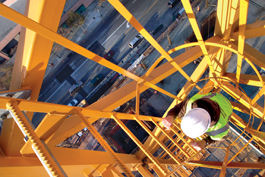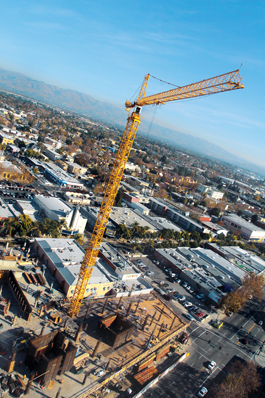home | metro silicon valley index | features | silicon valley | feature story

Photograph by Felipe Buitrago
HAVING THE CLIMB OF MY LIFE: The author makes the climb up the 20-story tower crane operated by Leon Benjamin.
Looking Down on Creation
The best view of San Jose's new era of high-rise development can be found in a small metal box 20 stories up
By Stett Holbrook
THE VIEW from Leon Benjamin's tiny office is stunning, the best in Silicon Valley bar none. On a clear day he can see all the way to the Sierra and San Francisco. The verdant Coastal Range spreads out before him to the west while the tawny Diablo Range rolls gently to the east. In between, he has an eagle's view of Silicon Valley's coursing freeways, building tops, neighborhoods and a steady stream of passing airplanes descending into SJC. In addition to the view, the other pluses of Benjamin's workplace include the absence of visits from overly chatty co-workers, no boring meetings, plenty of privacy and lots of fresh air. That's the upside. The downside is, well, 250 feet below, about 20 stories straight down.
Benjamin's "office" is the white cab perched atop the spindly yellow tower crane above the construction site at Market Street and San Salvador in downtown San Jose. He spends 10 to 12 hours a day manning the controls of the crane in a 6-foot-by-7-foot box hoisting steel columns, concrete forms and rebar for construction of 360 Residences, a 23-story luxury condo scheduled for completion in spring of 2009.
When done, the gleaming glass building will house more than 200 luxury condos ranging in prices from $600,000 to nearly $2 million. The building is the first of its kind in the SoFA district and will include retail space at the ground level, a pool, a grassy terrace and two penthouse suites. Half of the units have already been sold.
Projects like 360 Residences are ushering in the era of the high rise in downtown San Jose. Where once you would have had trouble filling a phone booth with downtown residents, there are now more than 10 high-rise condo and apartment buildings either in the works or in the planning stage. More than 5,000 housing units have recently been built downtown and another 4,500 are in the planning stage.
The scarcity of retail stores and restaurants has been blamed in part on the area's dearth of residents. But without a sufficient number of downtown residents, retailers have been reluctant to open new businesses. That could change with San Jose's high-rise boom.
The city's Redevelopment Agency, which has partnered with developers to bring many of the high projects about, says getting more people to live downtown is the most important ingredient in a more vibrant city core.
In the meantime, tower crane operators like Benjamin are going to be in high demand. In fact, they're always in high demand. Believe it or not, not many people want to work in a steel box hundreds of feet in the air with clenched bowels while they lift thousands of pounds of steel and do their best to avoid swinging their load into nearby buildings or killing anyone below. With overtime, an experienced tower crane operator can make $200,000. They deserve every bit of it.
Benjamin spends his day on the radio communicating with a "rigger" below. The rigger tells Benjamin what to pick up and where. Because many of his "picks" are out of view, Benjamin relies on his rigger to guide him to the right spot. He grabs the 1,500-pound hook at the end of the cable dangling from the crane's jib (sometimes called a "headache ball" because of what happens if it makes contact with a human head), connects it and tells Benjamin to hoist away. Because clear communication is so critical, only four people are allowed to communicate with Benjamin.
Meanwhile, if he has to do more than pee, he's out of luck. In addition to being trained in the operation of a critical piece of equipment that rents for about $2,500 a day, tower crane operators are also practiced at holding it. To climb down the tower, walk into a Porta-Potty, do his business and then climb back up would cost the tower project $2,400 in lost time. That's an expensive shit. So he holds it. Urine goes into a plastic bottle.

Photograph by Felipe Buitrago
USE YOUR ILLUSION: An aerial shot of the crane at Market Street and San Salvador in San Jose. Though it may not look it, the structure is as long horizontally as it is vertically.
Climb and Punishment
After a lot of negotiating over liability issues—with good reason, for once—I got to see where Benjamin works. It's not a trip for the faint of heart.
Just after sun-up I donned a hard hat, reflective vest and safety goggles and climbed up the staircase that runs up the crane. It's a fire-escape-like ladder that seems to go on forever. At 7:30am, the steel rungs were very cold and began to hurt my hands. But I wasn't about to loosen my grip. About half way up my legs started to wobble and I had to consciously slow my breathing. Then I made the mistake of focusing on the people down below. They looked very small. Gazing into the distance didn't help either, so I just put one hand above the other and kept climbing. It took about 20 minutes to reach the top.
At the top of the ladder is a small portal where Benjamin squeezes through and makes the final climb into the cab. I wasn't permitted to go that high, lest I distract him and cause him to drop a load of iron onto of passing cars. But I got high enough.
Thick steel beams surround the ladder, so the possibility of falling is low. But being that high in the open air feels completely unnatural. Throw in the twisting and swaying motion of the crane as Benjamin pivoted and hoisted thousands of pounds of steel and I thought not about falling out but falling down with the crane. I started to wonder about the efficacy of my hard hat. But thanks to a massive foundation rooted to the earth with pilings driven 100 feet deep and high toque bolts as big around as the small end of a baseball bat that cost $1,200 a piece, the crane didn't topple over and I made sit safely back to terra firma. It wasn't yet 9am, but all of a sudden I craved a beer.
For Benjamin, climbing up that stairway to heaven is just part of his commute to work, a trek that begins well before dawn at his home in Modesto.
Benjamin's boss is Rob Terheyden, a square-jawed man with slicked-back hair who works for Clipper International, a tower crane contractor based in South San Francisco. He's been running cranes for 30 years.
"My brother-in-law was a tower crane operator and I was fascinated with it," he said. "I went up into a tower crane with him and I knew what I wanted to do for the rest of my life. It's like a video game. You've got toggles and switches. But after you go through that enamoring stage after six months of working 10 hours a day you realize it's really work."
Because crane operators are in such demand, Bovis Lend Lease, general contractor for the high rise, started looking for an operator three months before they needed one, said Todd Taylor, supervisor for the project.
"It's a small group of people and there's only a select few that we use," he said. "Most of them get their jobs based on their reputation."
He's hoping to hire the crane operator for The 88, another high-rise condo development on San Fernando, to give Benjamin a break. That 406-unit, 286-foot tower is further along than 360 Residences and the crane is scheduled to come down any day.
"There's quite a bit of competition for them," he said. "There are not too many people that want to do it. It's a challenging job."
Because cranes are so expensive to use—monthly rent run between $20,000 to $35,000—it's critical to maximize their use.
"If I see that jib not moving, somebody is going to be answering to me why," said Taylor. "It better be moving all the time. I don't want that crane sitting idle. It's too important."
Terheyden said running a crane is not physical work since the operator sits all day, but the mental demands are great.
"The common thread with tower crane operators is you have to have someone who's cool, calm and collected and able to multitask and wear a lot of hats because you have to do a lot of things at once," he said. "And they can't be afraid of heights, that's for sure."
Send a letter to the editor about this story.
|
|
|
|
|
|